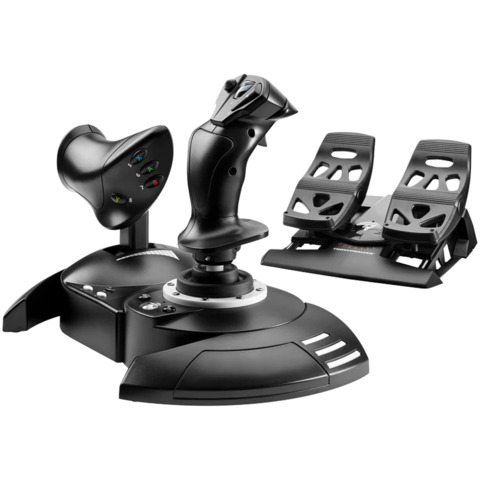
A good joystick or a yoke and rudder pedals won't break the bank! Many of the latest FS aircraft have also been specifically developed for use with the latest VR headsets and this is becoming an increasingly popular way to fly. Buying a yoke and rudder pedals is generally the next step, although certainly not essential, and will replicate even better the sensation of flying a real aircraft. We’d recommend buying a joystick with a ‘hat switch’ (a thumb-operated multi-position control at the top of the stick) which is invaluable for scanning the cockpit and views in all directions. Most FS pilots start with a joystick (which includes a throttle, rudder controls and various button assignments) and this is perfectly adequate for enjoyable flying. We’d also recommend a joystick or yoke and rudder pedals to control your aircraft. Generally speaking, the better specified the PC, the better the visuals and fluidity of your FS experience will be.

It’s worth noting that a good ‘business’ machine may not be as suitable as a machine designed for gaming - the quality of the graphics card is particularly important for flight simulation. Laptops are generally not suitable as they are usually less powerful in the processing and graphics areas, and often have smaller and slower hard drives.
#BEST FLIGHT SIMULATOR PC WINDOWS 10#
We’d suggest, as a minimum, that you have a Desktop PC running the Windows 10 operating system, a modern processor (such as the latest generation of Intel Core i7) with a speed of 2GHz or faster, 8GB of RAM, a dedicated graphics card such as the nVidia GTX 770 or AMD Radeon RX 570, 1TB of hard drive space, mouse, sound card and speakers. Hardware - You’ll need a reasonably powerful PC, but nothing that isn't readily available from your usual PC retailer. Getting airborne requires a minimum of equipment (hardware) and flight simulation programs (software).

WHAT EQUIPMENT DO I NEED TO GET STARTED IN FLIGHT SIMULATION?

#BEST FLIGHT SIMULATOR PC INSTALL#
Flight simulation software and hardware are designed to install easily and work with a minimum of fuss, and FS enthusiasts range from those still at school to virtual pilots who are long past retirement age and are using computers specifically to enjoy simulated flying. Not at all, although familiarity with the usual functions of a PC will obviously be necessary. You can fly the exact same airline routes that exist in the real world, or create your own flight plans and fly into countries and places you’d never normally have the opportunity to visit.ĭO I NEED TO BE A COMPUTER EXPERT TO ENJOY PC FLIGHT SIMULATION? Practising a touch-and-go in a Cessna is as accessible as shooting an ILS approach in a Jumbo Jet. It’s up to you whether you take off from your local airstrip or the busiest international airports around the world. The entire world is available for you to fly in, from Antarctica to Zanzibar and all points in between. It’s possible to fly civil and military planes from every era of aviation - helicopters, jets, microlights, gliders and propeller-driven aircraft.

Test your skills in an aerobatic competition, seek out thermals in a glider or even manage and fly for your own air freight company. You can fly a huge range of General Aviation aircraft, flash across the Atlantic in Concorde and take the controls of a modern airliner, or perhaps you’d prefer a sortie in a classic Spitfire or a mission in a modern Tornado or F-15 Eagle. One of the most appealing aspects of flight simulation is that there are absolutely no limits on what you can fly or where you can fly it. The short answer is… almost anything that can be (or has been!) flown in real-world aviation. WHAT EXACTLY CAN I FLY IN A PC FLIGHT SIMULATOR? Getting started in flight simulation can be a mystifying process, so here are some Frequently Asked Questions which should help you if you’re thinking of getting airborne on your PC. The processing power of today’s PCs means that virtual flying is both extremely realistic and also affordable. Flying on your home computer using flight simulation (FS) software is accessible, rewarding, great fun and can substantially improve your understanding of real-world aviation.


 0 kommentar(er)
0 kommentar(er)
